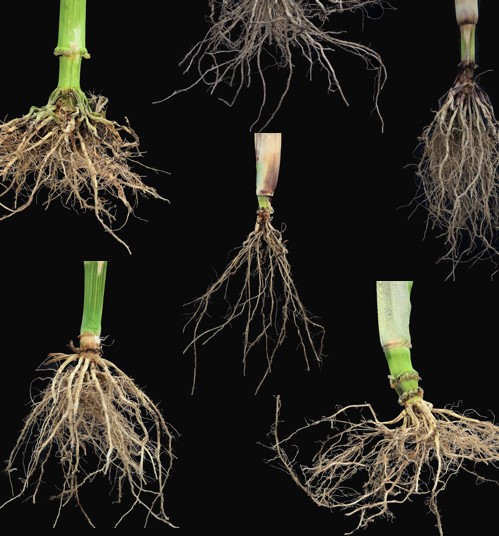
Greenhouse nightclub
Mood lighting at night in Penn State greenhouses from new LED lights.
Hi, I'm Steph! I grew at the edge of Chicago suburbia and made my way to the University of Illinois at Urbana-Champaign where I stumbled into agricultural research. There, I had the unique opportunity to work at the SoyFACE facility where I saw firsthand how climate change would affect our crops in the coming decades. It was also the first time I was introduced to the wild world underground.
I began my graduate degree at Penn State University in 2014 as part of the Roots Lab. My dissertation work was multi-disciplinary as I used plant physiology, stastical approaches, and genetics to study maize root hydraulic traits and trait combinations that better withstand terminal drought stress. Since defending my PhD in 2020, I still find myself interested in addressing these same questions but from a systems biology perspective. What is the genomic basis of root phenotypes? How can we identify genes regulating root responses to stress?
Now, I am a USDA-NIFA Postdoctoral Fellow at Iowa State University in the Anderson Genomics Lab looking to bridge the gap between genotype and phenotype. Because they contribute significantly to maize genotypic diversity, we are looking at transposable elements as drivers of phenotypic variation and responses to abiotic stress.
When I'm not sciencing, I am an avid sports fan. If I'm not studying statistics for fantasy football, I'm probably catching up college basketball or playing golf or tennis. I also enjoy baking, hiking, gardening, and reading.

Though Iowa has some of the most fertile soil in the world, farmers regularly apply nitrogen fertilizer in excess causing significant ecological damage to the surrounding waterways. Therefore, developing maize lines that can grow well with less nitrogen would be more sustainable for Iowa agriculture but would also benefit regions with less fertile soils.
Roots are one way in which we can improve nitrogen capture efficiency. In particular, we know the angle at which roots grow can play a big role in optimizing nitrogen capture. But what we don't understand is how is root growth angle controlled and how does root growth angle change in response to variable nitrogen availability?
The bulk of my current work seeks to understand how genotypic variation is related to the extensive variation we see in root growth angle within maize.

Check out the quick links below to learn more about my research and the activities I participate in. Links to my email and social media accounts are at the bottom.
Click here to read my full CV.
Check out my full publication list at my Google Scholar or ORCID profiles.
Select posters presented at conferences can be found at this Dropbox folder.
Check out my GitHub for all analytical pipelines and data used for my research.
Download root architecture and anatomy data collected as part of this project at Zenodo.
Check out these short videos going over the basic symptoms of various nutrient disorders, like nitrogen or phosphorus deficiency. Co-created with Chris Strock.
Join us in Les Diablerets, Switzerland to learn more on the latest in osmotic stress research. Learn more here.
The American Society of Plant Biologists benefits from the many early career researchers that serve on various committees and in professional development programs. Feel free to ask me about the many ways that early career members can get involved or check out the ASPB Early Career Plant Scientists Section for more info.
A collection of images captured from my work in the field and greenhouse.

Mood lighting at night in Penn State greenhouses from new LED lights.

Much of our large drought studies occurred at the Apache Root Biology Center nearby Willcox, AZ.

Drought was simulated in Pennsylvania using these rainout shelters at the Russell E. Larson Agricultural Research Center.

A closer look at the effects of our induced drought treatment (left) in the rainout shelters compared to the rainfed plots (right).

Every year the plastic on the rainout shelters was replaced.

The Apache Root Biology Center had some beautiful sunsets, always a nice treat after a long day of digging.

This maize root system was harvested from a mesocosm about 6 weeks after planting. It's as tall as me!

A beautiful field of sunflowers on a perfect summer's day nearby our fields in Hancock, WI.

A LICOR-6400 Portable Photosynthesis System used to measure gas exchange in the field.

My pupper, Ouija, the best corn dog a girl can ask for.

A perfect day for more root excavation from the field this time to investigate nitrogen stress effects.

A young maize seedling grown in the greenhouse in a conetainer.

Our first year at inducing nitrogen stress (right) showed a noticeable height reduction compared to the control (left).